The Geochemistry, Petrogenesis, and Rare-Metal Mineralization of the Peralkaline Granites and Related Pegmatites in the Arabian Shield: A Case Study of the Jabal Sayid and Dayheen Ring Complexes, Central Saudi Arabia
Abstract
1. Introduction
- (1)
- What are the specific mechanisms involved in the petrogenesis of the peralkaline granites and related pegmatites in the Jabal Sayid and Dayheen areas?
- (2)
- What are the geochemical similarities or differences among the peralkaline granites and related pegmatites in the Jabal Sayid and Dayheen areas?
- (3)
- What is the significance of the rare metal data in terms of the granitic evolution in both the Jabal Sayid and Dayheen areas? The researchers aim to understand how rare metals, including REEs, Zr, Y, Nb, U, and Th, are concentrated and fractionated during the late-stage magmatic processes that have influenced the evolution of the granitic systems in these areas.
- (4)
- What is the role of crystallization, partial melting, and the nature of the source protolith in shaping the rare-metal granitic systems in the Jabal Sayid and Dayheen areas?
2. Geological Settings
2.1. Dayheen Ring Complex
2.2. Jabal Sayid
3. Analytical Techniques
4. Petrography
4.1. Dayheen Ring Complex
4.1.1. Peralkaline Granites
4.1.2. Monzogranite
4.1.3. Pegmatite
4.2. Jabal Sayed
4.2.1. Peralkaline Granite
4.2.2. Pegmatite
5. Geochemistry
5.1. Major and Trace Element Characteristics
5.2. REEs Characteristics
5.3. Rare Metal Contents
6. Discussion
6.1. Tectonic Setting
6.2. The Petrogenesis of the Jabal Sayid and Dayheen Granitoids
6.2.1. Subduction-Related Granitoids
6.2.2. Collision-Related Granitoids
6.2.3. Post-Orogenic or Anorogenic Granitoids
6.3. Genesis of Rare Metals
6.4. Genetic Model
- (a)
- Subduction-related magmatism: During this stage, the early mafic magma produced subduction-related granodiorite–diorite in the early stage of underplating. This mafic magma, likely derived from the subducting oceanic lithosphere, interacted with the overlying continental crust. The interaction resulted in the production of subduction-related granodiorite–diorite (Figure 16A). This stage represents the initial phase of magmatic activity related to subduction. Slab breakoff can lead to a change in subduction dynamics and the cessation of subduction-related magmatism. Subduction initiation and the formation of arc terranes occurred between 870 and 620 Ma [10].
- (b)
- Collision-related magmatism: As the tectonic processes continued, crustal thickening occurred in the region, and consequently the subducted oceanic slab broke off (Figure 16B). The deeper portions of the overlying crust, composed of metatonalites and graywackes, were subjected to increased pressure and temperature conditions. These conditions brought these rocks above their solidus temperatures, leading to partial melting. The resulting melt contributed to the early mafic magma, giving rise to a new generation of intermediate magma that produced monzogranites. Ref. [6] reported zircon U-Pb ages of 625 ± 11 Ma for the hornblende–biotite granite and 613 ± 4 Ma for the monzogranite in the core of the Dayheen ring complex. These ages suggest that the monzogranite is younger than the rimmed hornblende–biotite granite. This age relationship contradicts the interpretation based on the present geochemical results, which suggest that the monzogranite is related to the collision stage, while the hornblende–biotite granite formed later in a post-collision stage. This implies that the monzogranite in the core of the ring complex is indeed older than the peralkaline rocks in the rim, consistent with the geological fact that the monzogranite was emplaced earlier than the rimmed granitic rocks, as stated by [56].
- (c)
- Post-collision magmatism: The geochemistry and previous geochronology show that the Dayheen and Jabal Sayid rare-metal-bearing peralkaline granites and related pegmatites were probably generated in a post-collision extensional setting. During this stage, anatexis, or partial melting, took place in the crustal material, leading to the generation of a new magma, which produced peralkaline granites and related pegmatites (Figure 16C). The magma composition was likely influenced by progressive chemical fractionation processes, which caused the development of peralkaline A-type granites and related pegmatites. The development of the Najd fault system is believed to have facilitated the ascent of magmas and the formation of peralkaline granitoids within the AS [9,57,58,59,60,61]. This fault system provided pathways for the upward migration of magmas from deeper levels to shallower crustal levels, where they eventually crystallized and formed peralkaline granitoids. The extensive crystallization and differentiation processes that occur during the emplacement and cooling of post-collision granite magma can lead to the enrichment of rare metals and other related elements in the Jabal Sayid and Dayheen areas.

7. Conclusions
Author Contributions
Funding
Institutional Review Board Statement
Informed Consent Statement
Data Availability Statement
Acknowledgments
Conflicts of Interest
References
- Drysdall, A.R.; Douch, C.J. Nb–Th–Zr mineralization in microgranite—Microsyenite at Jabal Tawlah, Midyan region, Kingdom of Saudi Arabia. J. Afr. Earth Sci. 1986, 4, 275–288. [Google Scholar]
- Küster, D. Granitoid-hosted Ta mineralization in the Arabian-Nubian Shield: Ore deposit types, tectono-metallogenetic setting and petrogenetic framework. Ore Geol. Rev. 2009, 35, 68–86. [Google Scholar] [CrossRef]
- Johnson, P.R.; Andresen, A.; Collins, A.S.; Fowler, A.R.; Fritz, H.; Ghebreab, W.; Kusky, T.; Stern, R.J. Late Cryogenian-Ediacaran history of the Arabian-Nubian Shield: A review of depositional, plutonic, structural, and tectonic events in the closing stages of the northern East African Orogen. J. Afr. Earth Sci. 2011, 61, 167–232. [Google Scholar] [CrossRef]
- Moghazi, A.M.; Harbi, H.M.; Ali, K.A. Geochemistry of the Late Neoproterozoic Hadb adh Dayheen ring complex, Central Arabian Shield: Implications for the origin of rare-metal-bearing post-orogenic A-type granites. J. Asian Earth Sci. 2011, 42, 1324–1340. [Google Scholar] [CrossRef]
- Bakhsh, R.A.M. Granites from the Midyan Terrain, NW Saudi Arabia: Petrology, Geochemistry and Geochronology. Ph.D. Thesis, Royal Holloway, University of London, Egham, UK, 2013; 250p. [Google Scholar]
- Ali, K.A.; Jeon, H.; Andresen, A.; Li, S.Q.; Harbi, H.M.; Hegner, E. U-Pb zircon geochronology and Nd-Hf-O isotopic systematics of the Neoproterozoic Hadb adh Dayheen ring complex, Central Arabian Shield, Saudi Arabia. Lithos 2014, 206–207, 348–360. [Google Scholar] [CrossRef]
- Moghazi, A.K.M.; Iaccheri, L.M.; Bakhsh, R.A.; Kotov, A.B.; Ali, K.A. Sources of rare-metal-bearing A-type granites from Jabel Sayed complex, northern Arabian shield, Saudi Arabia. J. Asian Earth Sci. 2015, 107, 244–258. [Google Scholar] [CrossRef]
- Aseri, A.A. Rare-Metal Alkaline Granite from the Arabian Shield, Saudi Arabia. Electronic Thesis and Dissertation Repository. 6822. 2020. Available online: https://ir.lib.uwo.ca/etd/6822 (accessed on 1 March 2020).
- Abuamarah, B.A.; Azer, M.K.; Asimow, P.D.; Shi, Q. Petrogenesis of the post-collisional rare-metal-bearing Ad-Dayheen granite intrusion, Central Arabian Shield. Lithos 2021, 384–385, 105956. [Google Scholar] [CrossRef]
- Tong, Q.; Li, Z.; Fan, H.; Jahdali, N.; Al-Nahdi, M.M. Petrogenesis and Tectonic Implications of the Jabal Hadb Ad Dayheen Granitic Complex, Central Arabian Shield. J. Earth Sci. 2023, 34, 20–36. [Google Scholar] [CrossRef]
- Worku, H.; Schandelmeier, H. Tectonic evolution of the Neoproterozoic Adola Belt of southern Ethiopia: Evidence for a Wilson Cycle process and implications for oblique plate collision. Precambrian Res. 1996, 77, 179–210. [Google Scholar] [CrossRef]
- Fritz, H.; Abdelsalam, M.; Ali, K.A.; Bingen, B.; Collins, A.S.; Fowler, A.R.; Ghebreab, W.; Hauzenberger, C.A.; Johnson, P.R.; Kusky, T.M.; et al. Orogen styles in the East African Orogen: A review of the Neoproterozoic to Cambrian tectonic evolution. J. Afr. Earth Sci. 2013, 86, 65–106. [Google Scholar] [CrossRef]
- Blades, M.L.; Collins, A.S.; Foden, J.; Payne, J.L.; Xu, X.; Alemu, T.; Woldetinsae, G.; Clark, C.; Taylor, R.J.M. Age and hafnium isotopic evolution of the Didesa and Kemashi Domains, western Ethiopia. Precambrian Res. 2015, 270, 267–284. [Google Scholar] [CrossRef]
- Radain, A.A.M.; Kerrich, R. Peralkaline granite in the western part of the Arabian Shield. Bull. Fac. Earth Sci. King Abdulaziz Univ. 1980, 3, 117–130. [Google Scholar]
- Hackett, D. Mineralized aplite-pegmatite at Jabel Sayid, Hijaz region, Kingdom of Saudi Arabia. J. Afr. Earth Sci. 1986, 4, 257–267. [Google Scholar]
- Kretz, R. Symbols of rock-forming minerals. Am. Mineral. 1983, 68, 277–279. [Google Scholar]
- Calvez, J.-Y.; Alsac, C.; Delfour, J.; Kemp, J.; Pellaton, C. Geologic Evolution of Western, Central and Eastern Parts of the Northern Precambrian Shield; Saudi Arabian Deputy Ministry for Mineral Resources Open-File Report BRGM-OF-03-17; Ministry of Petroleum and Mineral Resources; Deputy Ministry for Mineral Resources: Jiddah, Saudi Arabia, 1983; 57p. [Google Scholar]
- Turkistany, A.R.A. Radioactive Pegmatite and Its Host Granites of Jabal Sayid, Saudi Arabia. Master’s Thesis (unpublished), King Abdulaziz University, Jiddah, Saudi Arabia, 1979. [Google Scholar]
- Ahmed, M.I. Report on the Reconnaissance Survey in Saudi Arabia; Saudi Arabian Directorate General of Mineral Resources Open-File Report DGMR-69; Directorate General of Mineral Resources: Jiddah, Saudi Arabia, 1957. [Google Scholar]
- Schaffner, D.F. Preliminary Report on Investigation of Radioactivity at Jebel Sayid; Saudi Arabian Directorate General Mineral Resources Open-File Report DGMR-74; Directorate General of Mineral Resources: Jiddah, Saudi Arabia, 1957. [Google Scholar]
- Turkistany, A.R.; Ramsay, C.R. Mineralized apogranite associated with alkali granite at Jabal Sa’id, Kingdom of Saudi Arabia. Deputy Minstry Miner. Resour. 1982, PP-1, 78–88. [Google Scholar]
- Dawood, H.Y.; Harbi, H.M.; Abd El-Naby, H.H. Genesis of kasolite associated with aplite-pegmatite at Jabel Sayid, Hijaz region, Kingdom of Saudi Arabia. J. Asian Earth Sci. 2010, 37, 1–9. [Google Scholar] [CrossRef]
- Bernard, B. A review of the relationships between granitoid types, their origins and their geodynamic environments. Lithos 1999, 46, 605–626. [Google Scholar] [CrossRef]
- De La Roche, H.; Leterrier, J.; Grandelaude, P.; Marchal, M. A classification of volcanic and plutonic rocks using R1R2-diagram and major-element analyses—Its relationships with current nomenclature. Chem. Geol. 1980, 29, 183–210. [Google Scholar] [CrossRef]
- Maniar, P.D.; Piccoli, P.M. Tectonic discrimination of granites. Geol. Soc. Am. Bull. 1989, 101, 635–643. [Google Scholar] [CrossRef]
- Wright, J.B. A simple alkalinity ratio and its application to questions of non-orogenic granite genesis. Geol. Mag. 1969, 106, 370–384. [Google Scholar] [CrossRef]
- Peccerillo, A.; Taylor, S.R. Geochemistry of Eocene calcalkaline volcanic rocks from the Kastamonu area, northern Turkey. Contrib. Miner. Petrol. 1976, 58, 63–81. [Google Scholar] [CrossRef]
- Frost, B.R.; Barnes, C.G.; Collins, W.J.; Arculus, R.J.; Ellis, D.J.; Frost, C.D. A geochemical classification for granitic rocks. J. Petrol. 2001, 42, 2033–2048. [Google Scholar] [CrossRef]
- Pearce, J.A.; Harris, N.B.W.; Tindle, A.G. Trace Element Discrimination Diagrams for the Tectonic Interpretation of Granitic Rocks. J. Petrol. 1984, 25, 956–983. [Google Scholar] [CrossRef]
- McDonough, W.F.; Sun, S. The composition of the Earth. Chem. Geol. 1995, 120, 223–253. [Google Scholar] [CrossRef]
- Batchelor, R.A.; Bowden, P. Petrogenetic Interpretation of Granitoid Rock Series Using Multicationic Parameters. Chem. Geol. 1985, 48, 43–55. [Google Scholar] [CrossRef]
- Pearce, J.A. Sources and settings of granitic rocks. Episode 1996, 19, 120–125. [Google Scholar] [CrossRef]
- Eby, G.N. Chemical subdivision of the A-type granites: Petrogenetic and tectonic implications. Geology 1992, 20, 641–644. [Google Scholar] [CrossRef]
- Eby, G.N. The A-type granitoids: A review of their occurrence and chemical characteristics and speculations on their petrogenesis. Lithos 1990, 26, 115–134. [Google Scholar] [CrossRef]
- Whalen, J.B.; Currie, K.L.; Chappell, B.W. A-type granites: Geochemical characteristics, discrimination and petrogenesis. Contrib. Mineral. Petrol. 1987, 95, 407–419. [Google Scholar] [CrossRef]
- Harris, N.B.W.; Pearce, J.A.; Tendle, A.G. Geochemical Characteristics of Collision-Zone Magmatism. In Collision Tectonics; Coward, M.P., Ries, A.C., Eds.; Geological Society, London, Special Publications: Bath, UK, 1986; Volume 19, pp. 67–81. [Google Scholar]
- Collins, W.J.; Beams, S.D.; White, A.J.R.; Chappell, B.W. Nature and origin of A-type granites with particular reference to southeastern Australia. Contrib. Mineral. Petrol. 1982, 80, 189–200. [Google Scholar] [CrossRef]
- Laurent, O.; Martin, H.; Moyen, J.; Doucelance, R. The Diversity and Evolution of Late-Archean Granitoids: Evidence for the Onset of “Modern-Style” Plate Tectonics between 3.0 and 2.5 Ga. Lithos 2014, 205, 208–235. [Google Scholar] [CrossRef]
- Tarney, J.; Jones, C.E. Trace element geochemistry of orogenic igneous rocks and crustal growth models. J. Geol. Soc. Lond. 1994, 151, 855–868. [Google Scholar] [CrossRef]
- Gerdes, A.; Montero, P.; Bea, F.; Fershater, G. Peraluminous granites frequently with mantle-like isotope compositions: The continental-type Murzinka and Dzhabyk batholiths of the eastern Urals. Int. J. Earth Sci. 2002, 91, 3–19. [Google Scholar] [CrossRef]
- Crawford, M.B.; Windley, B.F. Leucogranites Himalaya/Karakoram: Implications for magmatic evolution within collisional belts and the study of collision related leucogranite petrogenesis. J. Volcanol. Geothermal. Res. 1990, 44, 1–19. [Google Scholar] [CrossRef]
- Liégeois, J.P.; Bertrand, J.M.; Black, R. The subduction and collision-related Pan-African composite batholith of the Adrar des Iforas (Mali): A review. Geol. J. 1987, 22, 185–211. [Google Scholar] [CrossRef]
- Kemp, A.I.S.; Hawkesworth, C.J.; Foster, J.L.; Paterson, B.A.; Woodhead, J.D.; Hergt, J.M.; Gray, C.M.; Whitehouse, M.J. Magmatic and crustal differentiation history of granitic rocks from Hf-O isotopes in zircon. Science 2007, 315, 980–983. [Google Scholar] [CrossRef] [PubMed]
- Liégeois, J.P.; Navez, J.; Hertogen, J.; Black, R. Contrasting origin of post-collisional high-K calc-alkaline and shoshonitic versus alkaline and peralkaline granitoids: The use of sliding normalization. Lithos 1998, 45, 1–28. [Google Scholar] [CrossRef]
- Eyal, M.; Litvinovsky, B.; Jahn, B.M.; Zanvilevich, A.; Katzir, Y. Origin and evolution of post-collisional magmatism: Coeval Neoproterozoic calc-alkaline and alkaline suites of the Sinai Peninsula. Chem. Geol. 2010, 269, 153–179. [Google Scholar] [CrossRef]
- Gahlan, H.A.; Azer, M.K.; Asimow, P.D.; Al-Hashim, M.H. Geochemistry, Petrogenesis and Alteration of Rare-Metal-Bearing Granitoids and Mineralized Silexite of the Al-Ghurayyah Stock, Arabian Shield, Saudi Arabia. J. Earth Sci. 2023, 34, 1488–1510. [Google Scholar] [CrossRef]
- Münker, C.; Pfänder, J.A.; Weyer, S.; Büchl, A.; Kleine, T.; Mezger, K. Evolution of planetary cores and the Earth–Moon system from Nb/Ta systematics. Science 2003, 301, 84–87. [Google Scholar] [CrossRef]
- Pfänder, J.A.; Münker, C.; Stracke, A.; Mezger, K. Nb/Ta and Zr/Hf in Ocean Island Basalts—Implications for Crust-Mantle Differentiation and the Fate of Niobium. Earth Planet. Sci. Lett. 2007, 254, 158–172. [Google Scholar] [CrossRef]
- Hofmann, A.W. Chemical differentiation of the Earth: The relationship between mantle, continental crust, and oceanic crust. Earth Planet. Sci. Lett. 1988, 90, 297–314. [Google Scholar] [CrossRef]
- Wedepohl, K.H. The Composition of the Continental-Crust. Geochim. Cosmochim. Acta 1995, 59, 1217–1232. [Google Scholar] [CrossRef]
- Qadhi, T.M. Origin and hydrothermal alteration of rare-metal granites in the Al-Hamra area, northeastern Arabian Shield, Saudi Arabia. Cent. Eur. Geol. 2007, 50, 259–282. [Google Scholar] [CrossRef]
- Jarrar, G.H.; Mantonb, W.I.; Stern, R.J.; Zachmann, D. Late Neoproterozoic A-type granites in the northernmost Arabian-Nubian Shield formed by fractionation of basaltic melts. Geochemistry 2008, 68, 295–312. [Google Scholar] [CrossRef]
- Awad, A.A.; Abu El-Leil, A.; Nastavkin, A.V.; Tolba, A.; Kamel, M.; El-Wardany, R.M.; Rabie, A.; Ene, A.; Tekin, H.O.; Issa, S.A.M.; et al. Statistical analysis on the radiological assessment and geochemical studies of granite rocks in the north of Um Taghir area, Eastern Desert, Egypt. Open Chem. 2022, 20, 254–266. [Google Scholar] [CrossRef]
- Abd El-Naby, H.H.; Dawood, Y.H.; Sabtan, A.; Al Yamani, M. Significance of radioelements distribution in the Precambrian rocks of Jabel Sayid, western Saudi Arabia, using spectrometric and geochemical data. Resour. Geol. 2020, 71, 105–122. [Google Scholar] [CrossRef]
- Moghazi, A.M.; Ali, K.A.; Wilde, S.A.; Zhou, Q.; Andersen, T.; Andresen, A.; El-enen, M.M.A.; Stern, R.J. Geochemistry, geochronology, and Sr–Nd isotopes of the Late Neoproterozoic Wadi Kid volcano-sedimentary rocks, Southern Sinai, Egypt: Implications for tectonic setting and crustal evolution. Lithos 2012, 154, 147–165. [Google Scholar] [CrossRef]
- Radain, A.A. Petrogenesis of Some Peralkaline and Non-Peralkaline Post-Tectonic Granites in the Arabian Shield, Kingdom of Saudi Arabia. Ph.D. Thesis, University of Western Ontario, London, ON, Canada, 1978. [Google Scholar]
- Brown, G.B. Tectonic Map of the Arabian Peninsula. Saudi Arabian Directorate General of Mineral Resources Map, Scale 1:4,000,000; USGS: Reston, VA, USA, 1972.
- Greenwood, W.R.; Hadley, D.G.; Anderson, R.E.; Fleck, R.J.; Schmidt, D.L. Late Proterozoic cratonization in southwestern Saudi Arabia. Philos. Transact. R. Soc. Lond. Ser. A 1976, 280, 517–527. [Google Scholar]
- Greenwood, W.R.; Anderson, R.E.; Fleck, R.J.; Robert, R.J. Precambrian geologic history and plate tectonic evolution of the Arabian Shield. Saudi Arab. Dir. Miner. Resour. Bull. 1980, 24, 35. [Google Scholar]
- Stoeser, D.B.; Jackson, N.J.; Ramsay, C.R.; Drysdall, A.R.; Du Bray, E.A.; Douch, C.J. Map of Plutonic Rocks in the Arabian Shield, Kingdom of Saudi Arabia (Northern Sheet); Saudi Arabian Deputy Ministry for Mineral Resources Technical Record USGS-TR-04-5; USGS: Reston, VA, USA, 1985.
- Abdallah, S.E.; Azer, M.K.; Al Shammari, A.S. The Petrological and Geochemical Evolution of Ediacaran Rare-Metal Bearing A-Type Granites from the Jabal Aja Complex, Northern Arabian Shield, Saudi Arabia. Acta Geol. Sin. 2020, 94, 743–762. [Google Scholar] [CrossRef]
- Nehlig, P.; Genna, A.; Asfirane, F. A review of the Pan-African evolution of the Arabian shield. GeoArabia 2002, 7, 103–124. [Google Scholar] [CrossRef]
- Calvez, J.Y.; Kemp, J. Geochronological Investigations in the Mahd Ahd Dhahab Quadrangle, Central Arabian Shield: Saudi Arabian Deputy Ministry for Mineral Resources; Technical Report BRGM-TR-02-5; USGS: Reston, VA, USA, 1982.
- Djouka-Fonkwe, M.L.; Schulz, B.; Schüssler, U.; Tchouankoue, J.-P.; Nzolang, C. Geochemistry of the Bafoussam Pan-African I- and S-type granitoids in western Cameroon. J. Afr. Earth Sci. 2008, 50, 148–167. [Google Scholar] [CrossRef]

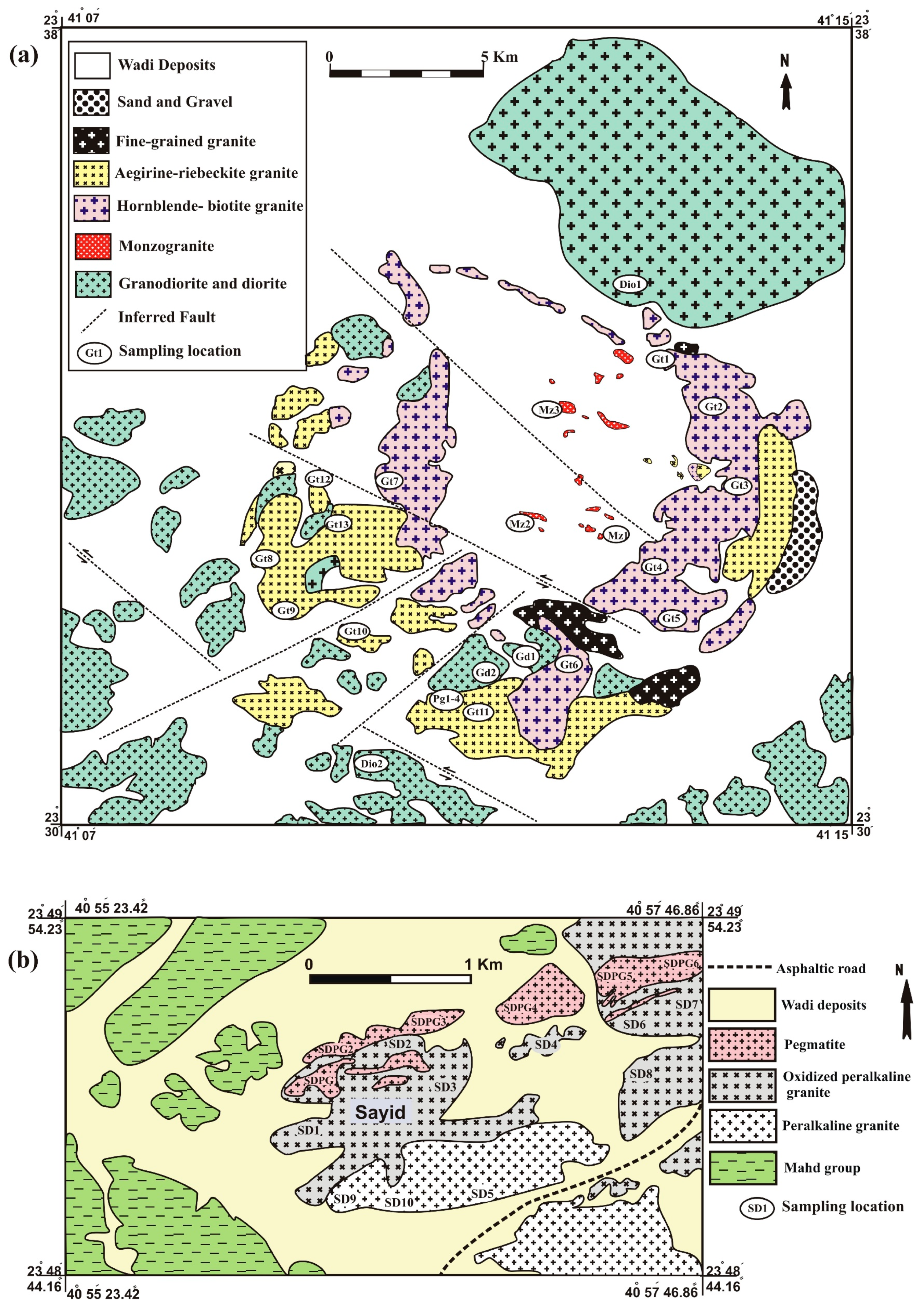
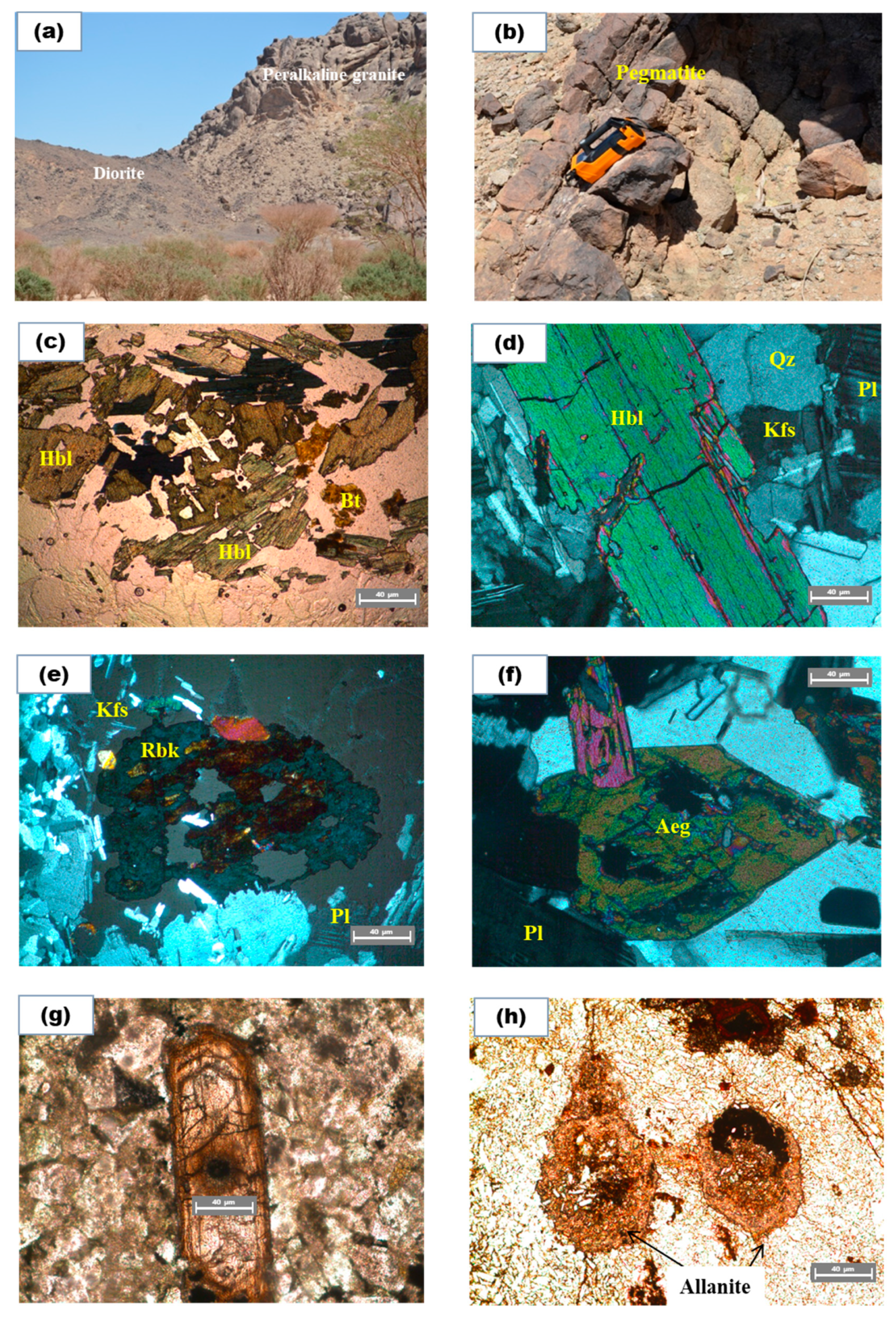


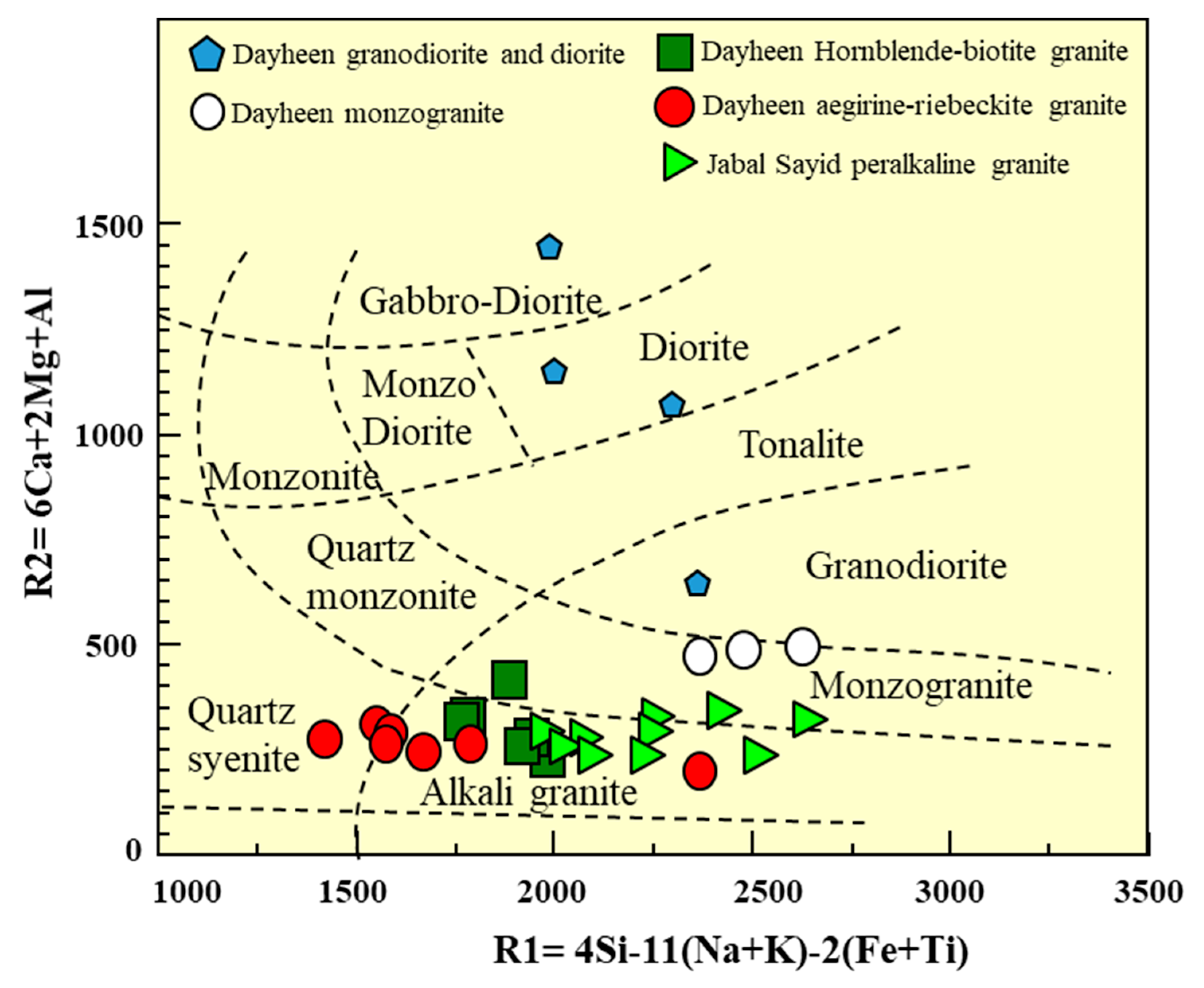
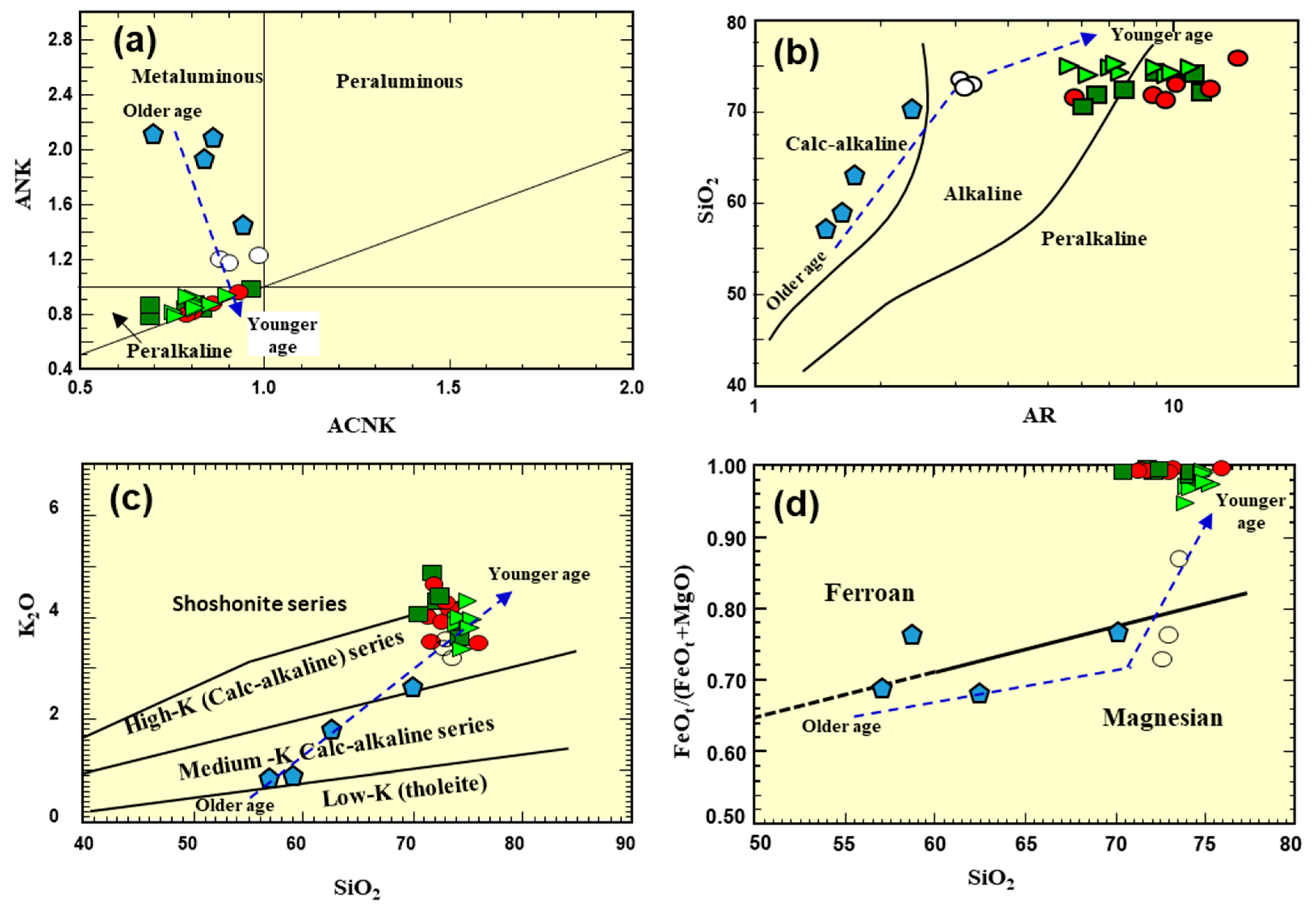
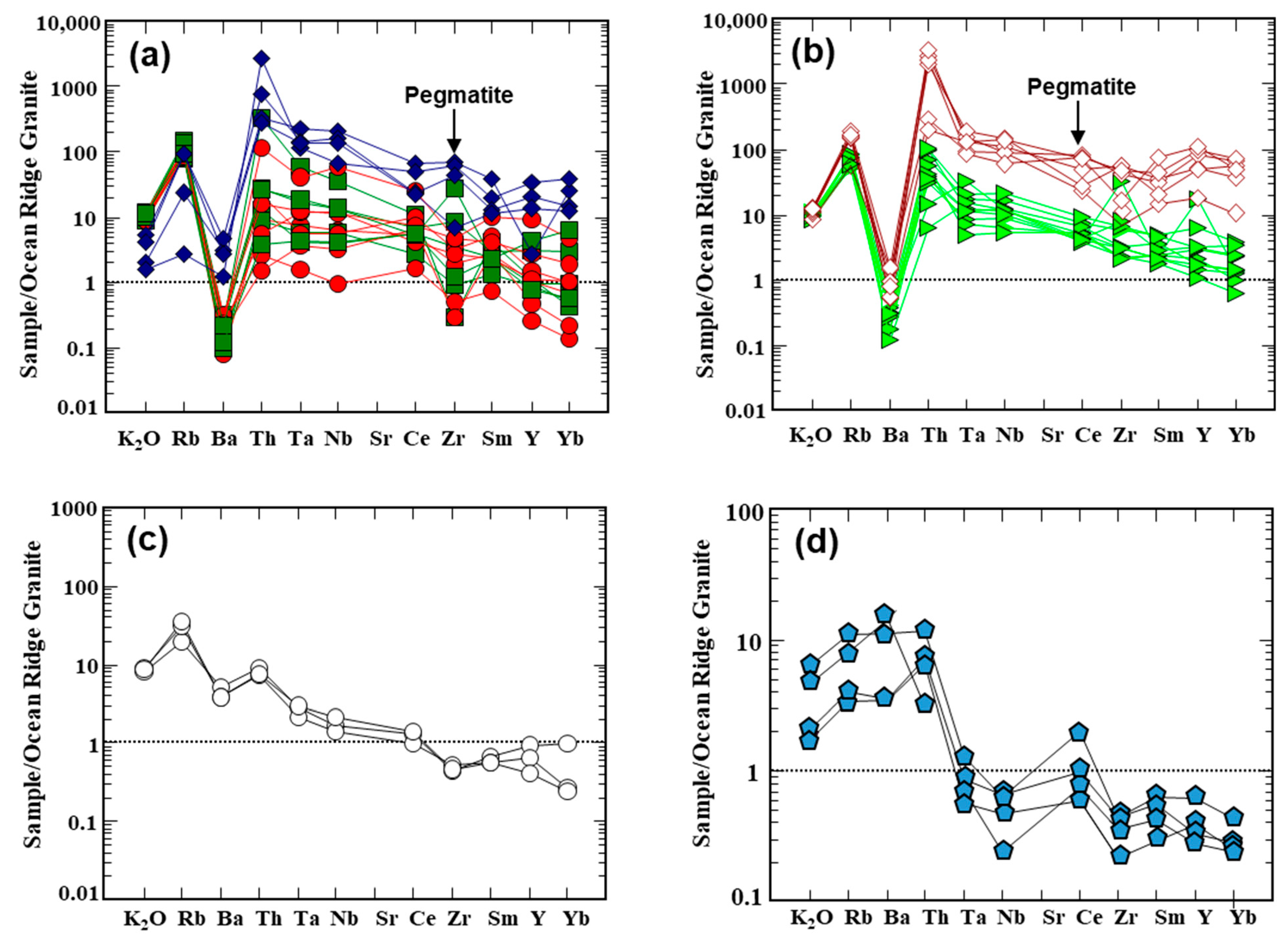
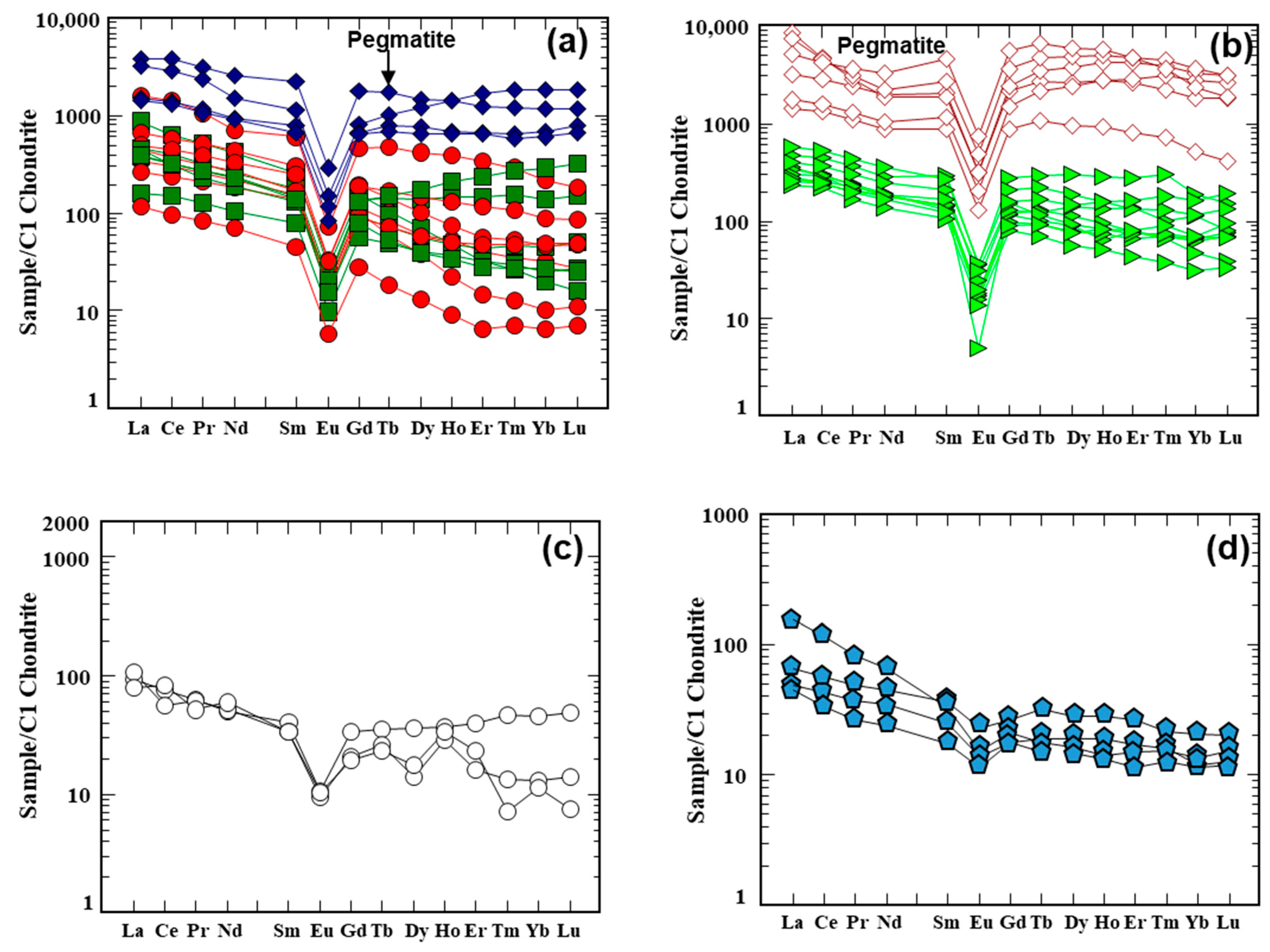
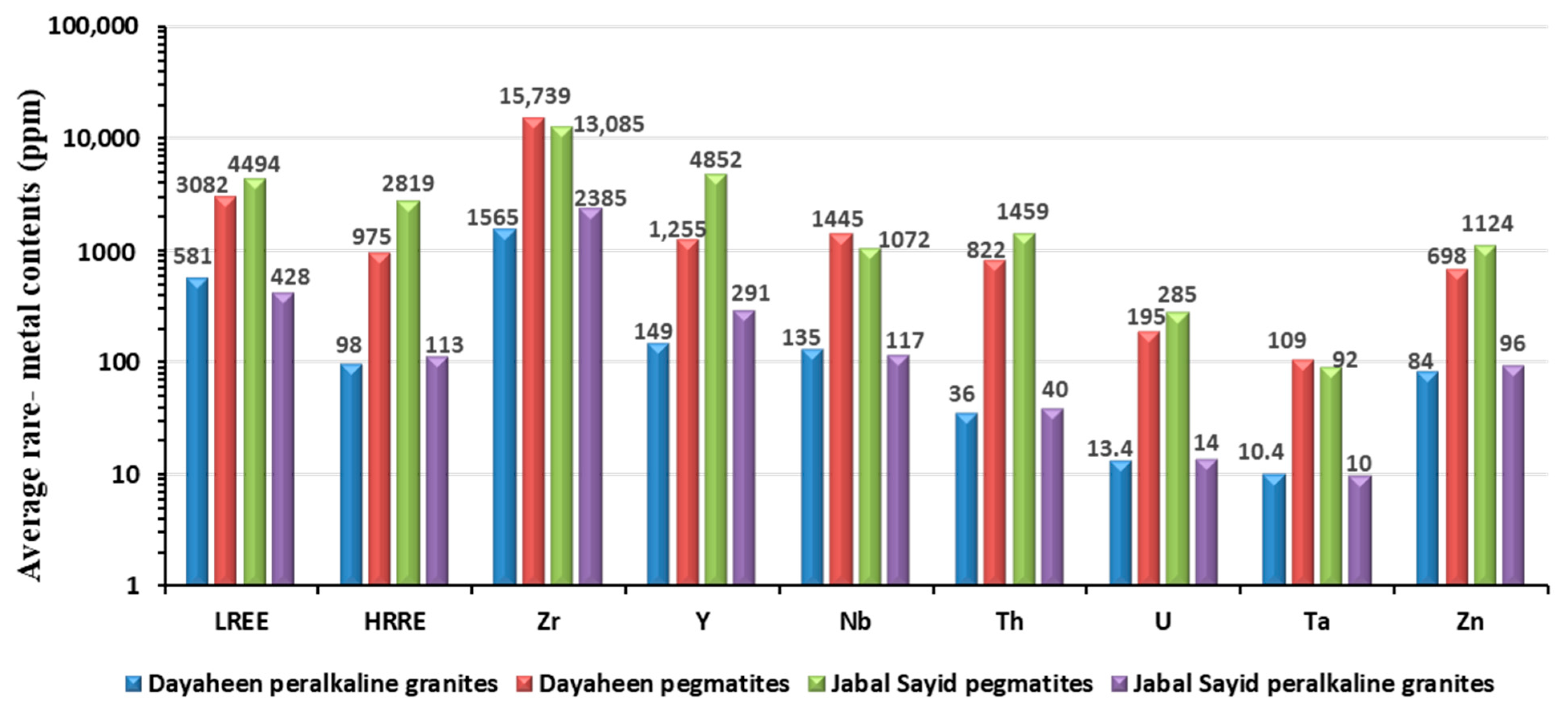
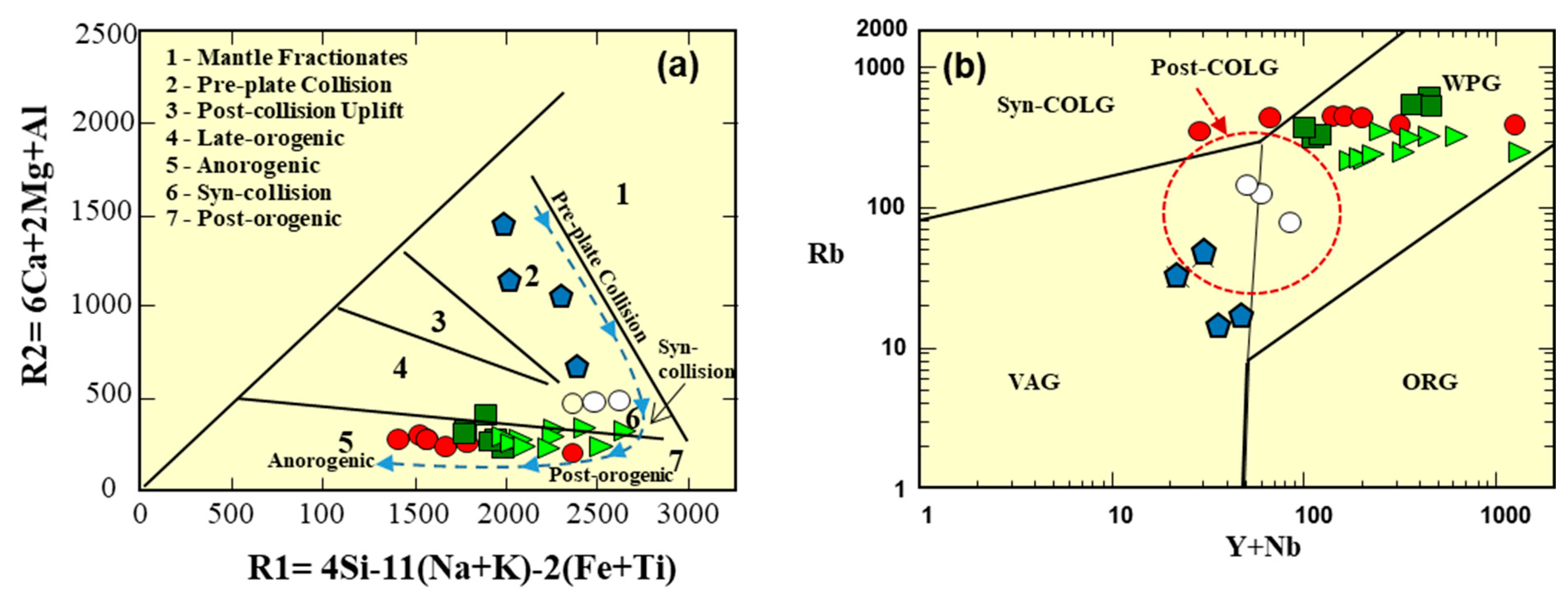
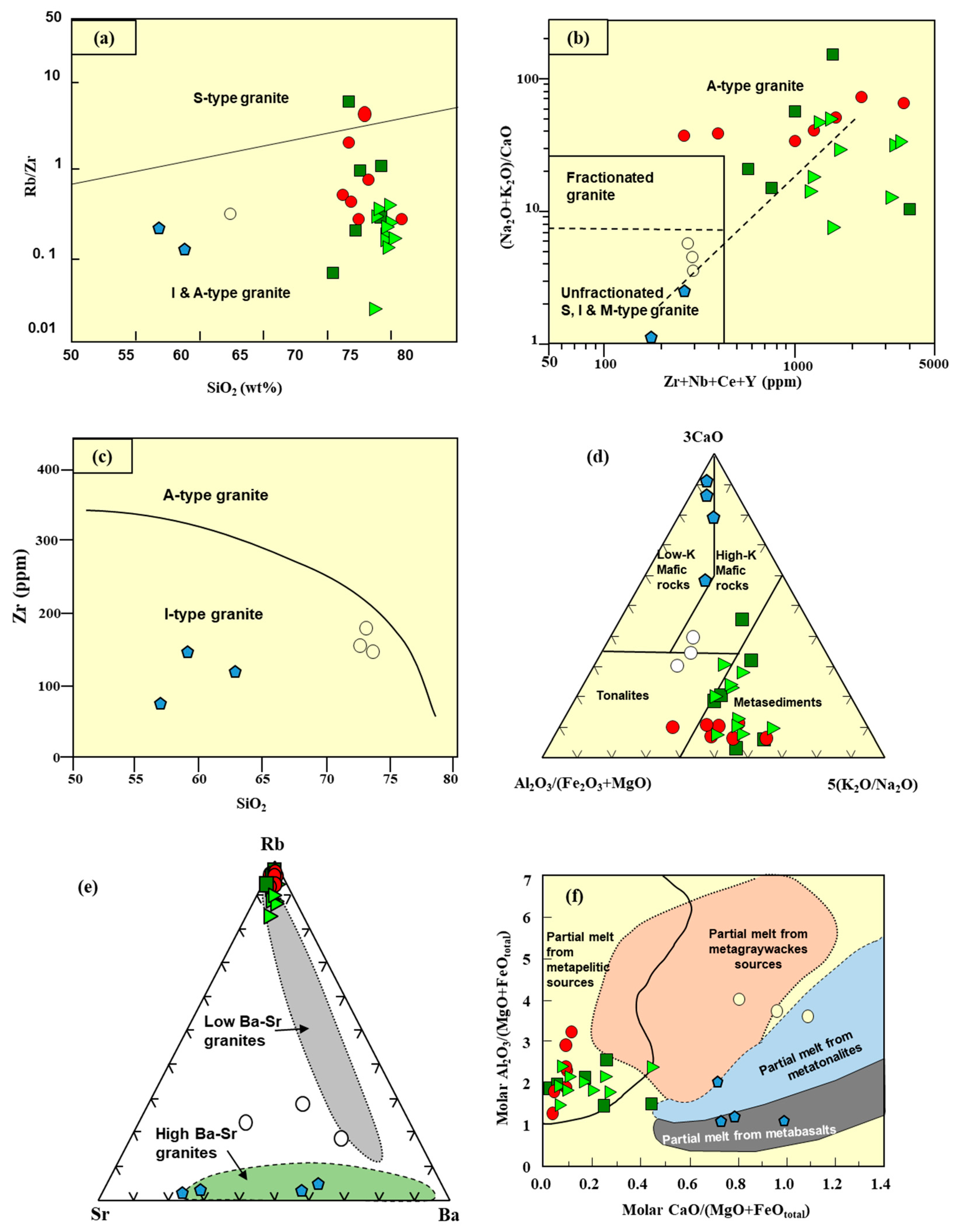
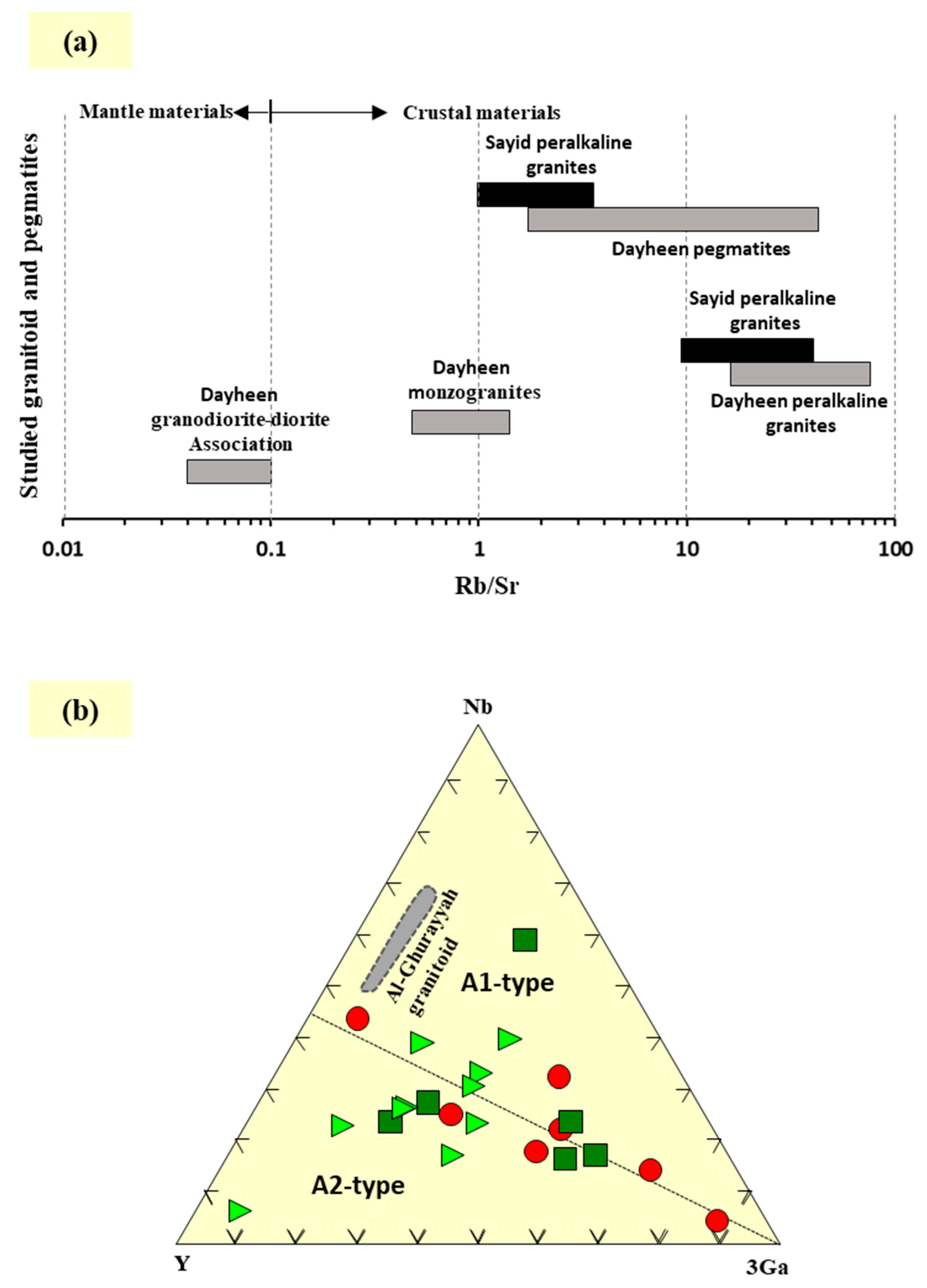


| Accessory Mineral Group | Dayheen | Jabal Sayid | ||
|---|---|---|---|---|
| Mineral Name | Formula | Mineral Name | Formula | |
| REEs-Ti-Zr association | Zircon Titanite | ZrSiO4 CaTiSiO5 | Synchysite Bastnaesite Titanite Zircon | (Ca, Ce(CO3)2F (Ca, La)(CO3)F CaTiSiO5 ZrSiO4 |
| REEs-Ca-P association | Apatite Allanite Monazite | Ca5(PO4)3(OH,F,Cl) (Ce,Ca)2(Al, Fe3+)3(SiO3)3(OH) (La,Ce,Nd,Th)PO4 | Xenotime Monazite | (Y, Yb)(PO4) (La,Ce,Nd,Th)PO4 |
| REEs-Y-Nb association | Pyrochlore Samarskite | (Na,Ca)2Nb2O6 (OH,F) (Y-Yb) Fe3+Nb2O8 | Pyrochlore | (Na,Ca)2Nb2O6 (OH,F) |
| Th-U-Pb minerals | thorite | ThSiO4 | Thorite Kasolite | ThSiO4 Pb(UO2)(SiO4)·H2O |
| Rock Type | DL * | Peralkaline Granites | Pegmatites | Monzogranites | Granodiorites | Diorites | |||||||||||||||||||
|---|---|---|---|---|---|---|---|---|---|---|---|---|---|---|---|---|---|---|---|---|---|---|---|---|---|
| Aegirine–Riebeckite Granite | Hornblende–Biotite Granite | ||||||||||||||||||||||||
| Sample | GT1 | GT2 | GT3 | GT4 | GT5 | GT6 | GT7 | GT8 | GT9 | GT10 | GT11 | GT12 | GT13 | PG1 | PG2 | PG3 | PG4 | MZ1 | MZ2 | MZ3 | GD1 | GD2 | Dio1 | Dio2 | |
| Major elements (wt%) | |||||||||||||||||||||||||
| SiO2 | 0.1 | 73.2 | 71.5 | 71.8 | 73.0 | 71.3 | 72.5 | 75.9 | 70.5 | 72.5 | 74.1 | 74.2 | 71.8 | 72.1 | 69.7 | 66.3 | 72.6 | 71.9 | 73.6 | 73.0 | 72.7 | 69.9 | 62.5 | 56.9 | 58.8 |
| TiO2 | 0.01 | 0.1 | 0.1 | 0.1 | 0.1 | 0.1 | 0.1 | 0.2 | 0.1 | 0.1 | 0.1 | 0.1 | 0.1 | 0.1 | 0.8 | 0.9 | 0.2 | 0.5 | 0.2 | 0.2 | 0.2 | 0.4 | 0.5 | 0.6 | 1.0 |
| Al2O3 | 0.01 | 11.6 | 14.2 | 12.9 | 12.5 | 12.8 | 11.6 | 9.6 | 11.0 | 12.3 | 11.2 | 11.3 | 12.7 | 10.6 | 7.8 | 9.6 | 10.5 | 10.0 | 12.6 | 13.0 | 14.0 | 14.7 | 15.7 | 16.3 | 16.8 |
| Fe2O3 ** | 0.01 | 4.2 | 3.1 | 3.1 | 3.8 | 3.8 | 4.5 | 5.3 | 5.0 | 3.4 | 4.1 | 3.7 | 4.5 | 5.0 | 9.4 | 7.7 | 6.0 | 5.4 | 2.0 | 1.6 | 1.5 | 3.3 | 5.5 | 5.9 | 6.4 |
| MnO | 0.01 | 0.02 | 0.02 | 0.04 | 0.04 | 0.04 | 0.05 | 0.04 | 0.07 | 0.04 | 0.05 | 0.04 | 0.02 | 0.06 | 0.09 | 0.06 | 0.09 | 0.06 | 0.05 | 0.04 | 0.04 | 0.07 | 0.10 | 0.10 | 0.12 |
| MgO | 0.01 | 0.01 | 0.01 | 0.02 | 0.03 | 0.02 | 0.02 | 0.01 | 0.04 | 0.01 | 0.05 | 0.03 | 0.01 | 0.04 | 0.24 | 0.22 | 0.19 | 0.15 | 0.29 | 0.49 | 0.55 | 1.02 | 2.60 | 2.76 | 2.03 |
| CaO | 0.01 | 0.3 | 0.3 | 0.2 | 0.3 | 0.3 | 0.1 | 0.1 | 1.7 | 0.7 | 0.1 | 0.5 | 0.2 | 1.0 | 0.7 | 1.1 | 0.7 | 0.8 | 2.1 | 1.8 | 1.5 | 2.8 | 5.6 | 8.3 | 6.1 |
| Na2O | 0.01 | 5.5 | 6.7 | 5.8 | 6.2 | 6.5 | 6.0 | 4.9 | 5.0 | 5.5 | 5.5 | 5.8 | 4.6 | 5.4 | 3.9 | 9.0 | 4.3 | 3.8 | 4.3 | 4.4 | 4.7 | 4.5 | 3.8 | 4.4 | 4.5 |
| K2O | 0.01 | 4.2 | 3.5 | 4.7 | 4.3 | 4.0 | 3.9 | 3.5 | 4.1 | 4.4 | 3.9 | 3.6 | 4.9 | 4.4 | 0.8 | 0.6 | 2.2 | 2.7 | 3.2 | 3.6 | 3.4 | 2.6 | 1.9 | 0.7 | 0.9 |
| P2O5 | 0.01 | 0.01 | 0.01 | 0.01 | 0.01 | 0.06 | 0.05 | 0.02 | 0.01 | 0.01 | 0.01 | 0.01 | 0.01 | 0.03 | 0.05 | 0.05 | 3.00 | 0.05 | 0.02 | 0.03 | 0.10 | 0.12 | 0.15 | 0.31 | 0.01 |
| Cr2O3 | 0.01 | 0.01 | 0.01 | 0.01 | 0.01 | 0.01 | 0.01 | 0.01 | 0.01 | 0.01 | 0.01 | 0.01 | 0.01 | 0.01 | 0.01 | 0.01 | 0.01 | 0.01 | 0.01 | 0.01 | 0.01 | 0.01 | 0.02 | 0.01 | 0.01 |
| LOI | −5.11 | 0.2 | 0.2 | 0.3 | 0.3 | 0.3 | 0.2 | 0.4 | 1.7 | 0.7 | 0.1 | 0.4 | 0.2 | 0.9 | 1.3 | 0.9 | 0.7 | 1.0 | 1.8 | 1.1 | 1.3 | 1.0 | 1.7 | 4.2 | 2.8 |
| SUM | 99.4 | 99.7 | 99.0 | 100.6 | 99.2 | 99.0 | 100.0 | 99.2 | 99.7 | 99.2 | 99.7 | 99.1 | 99.6 | 94.8 | 96.4 | 100.5 | 96.4 | 100.2 | 99.3 | 100.0 | 100.4 | 100.1 | 100.5 | 99.5 | |
| REEs (ppm) | |||||||||||||||||||||||||
| La | 0.1 | 82.4 | 27.7 | 161 | 106 | 62.3 | 120 | 360 | 108 | 94.2 | 89.2 | 38.9 | 204 | 109 | 907.6 | 759.0 | 361.0 | 337 | 22.2 | 25.5 | 18.9 | 36.8 | 11.6 | 10.8 | 15.7 |
| Ce | 0.1 | 187 | 59.0 | 358 | 227 | 146 | 273 | 870 | 191 | 195 | 196 | 93.4 | 385 | 247 | 2316 | 1731 | 848.7 | 779 | 46.2 | 34.5 | 50.2 | 70.2 | 26.4 | 20.8 | 34.6 |
| Pr | 0.02 | 24.1 | 7.9 | 48.2 | 29.8 | 20.1 | 37.6 | 99.2 | 21.7 | 25.7 | 26.0 | 12.1 | 48.5 | 30.5 | 300.5 | 219.0 | 110.5 | 101 | 6.0 | 5.7 | 5.0 | 7.9 | 3.6 | 2.5 | 4.7 |
| Nd | 0.3 | 101 | 32.6 | 206 | 126 | 87.2 | 154 | 334 | 89.3 | 109 | 111 | 49.3 | 194 | 119 | 1215 | 719.0 | 430.1 | 416 | 23.9 | 24.5 | 27.9 | 30.4 | 16.3 | 11.1 | 21.2 |
| Sm | 0.05 | 24.0 | 6.8 | 45.9 | 25.9 | 20.7 | 38.4 | 91.4 | 20.6 | 20.8 | 22.2 | 12.1 | 38.9 | 27.2 | 345.7 | 172.0 | 120.1 | 101 | 6.2 | 5.2 | 5.1 | 5.0 | 3.8 | 2.7 | 5.6 |
| Eu | 0.02 | 1.1 | 0.3 | 1.9 | 1.1 | 1.0 | 1.9 | 4.5 | 1.2 | 0.9 | 0.9 | 0.6 | 1.7 | 1.3 | 17.2 | 8.8 | 6.8 | 4.9 | 0.6 | 0.6 | 0.6 | 0.9 | 0.8 | 0.7 | 1.3 |
| Gd | 0.05 | 23.5 | 5.9 | 40.2 | 21.0 | 19.3 | 39.4 | 96.1 | 27.3 | 16.2 | 19.1 | 11.7 | 31.9 | 28.3 | 372.5 | 166.9 | 139.1 | 131 | 6.8 | 4.3 | 4.0 | 4.3 | 3.7 | 3.6 | 5.4 |
| Tb | 0.01 | 3.1 | 0.7 | 5.3 | 2.3 | 2.7 | 6.3 | 17.9 | 5.6 | 2.0 | 2.7 | 1.9 | 4.0 | 5.3 | 64.7 | 37.9 | 29.0 | 26.0 | 1.3 | 1.0 | 0.9 | 0.7 | 0.6 | 0.7 | 1.2 |
| Dy | 0.05 | 15.5 | 3.3 | 25.9 | 9.7 | 15.0 | 36.9 | 107 | 43.4 | 9.8 | 14.4 | 10.4 | 17.9 | 35.0 | 378.5 | 302.9 | 191.0 | 163 | 9.3 | 3.6 | 4.5 | 4.2 | 3.7 | 4.9 | 7.1 |
| Ho | 0.02 | 2.9 | 0.5 | 4.2 | 1.3 | 2.9 | 7.4 | 22.5 | 11.8 | 1.9 | 2.7 | 2.1 | 2.7 | 8.2 | 79.6 | 81.9 | 38.6 | 36.1 | 2.1 | 0.9 | 1.9 | 0.8 | 0.7 | 1.1 | 1.6 |
| Er | 0.03 | 6.7 | 1.1 | 9.3 | 2.4 | 7.8 | 19.5 | 57.6 | 39.5 | 4.6 | 7.2 | 5.3 | 5.3 | 24.6 | 209.6 | 278.9 | 112.0 | 106 | 6.5 | 2.7 | 3.9 | 2.5 | 1.9 | 2.8 | 4.3 |
| Tm | 0.01 | 0.9 | 0.2 | 1.4 | 0.3 | 1.2 | 2.8 | 7.4 | 7.0 | 0.7 | 1.2 | 0.8 | 0.7 | 3.9 | 31.2 | 46.9 | 16.3 | 15.0 | 1.2 | 0.3 | 0.2 | 0.4 | 0.3 | 0.4 | 0.6 |
| Yb | 0.05 | 5.4 | 1.1 | 7.9 | 1.7 | 8.3 | 15.2 | 36.5 | 49.0 | 4.6 | 7.5 | 4.3 | 3.5 | 23.6 | 196.2 | 313.9 | 118.3 | 103 | 7.7 | 2.2 | 1.9 | 2.3 | 1.9 | 2.0 | 3.5 |
| Lu | 0.01 | 0.7 | 0.2 | 1.2 | 0.3 | 1.3 | 2.2 | 4.7 | 8.1 | 0.7 | 1.3 | 0.7 | 0.4 | 3.9 | 29.5 | 47.0 | 19.8 | 17.0 | 1.2 | 0.4 | 0.2 | 0.4 | 0.3 | 0.3 | 0.5 |
| Trace elements (ppm) | |||||||||||||||||||||||||
| Y | 0.1 | 73.6 | 18.5 | 103 | 33.6 | 76.5 | 192 | 640 | 314 | 55.8 | 68.2 | 59.4 | 79.2 | 223 | 185.7 | 2399 | 1461 | 974 | 66.3 | 45.3 | 29.2 | 23.2 | 19.5 | 27.5 | 42.5 |
| Hf | 0.1 | 19.5 | 5.5 | 30.4 | 3.7 | 23.5 | 44.5 | 41.7 | 258 | 11.7 | 31.6 | 8.9 | 3.6 | 80.6 | 617.7 | 531.0 | 360.0 | 131 | 6.1 | 5.5 | 4.3 | 4.0 | 3.1 | 2.1 | 4.8 |
| Nb | 0.1 | 64.0 | 9.4 | 58.0 | 32.3 | 121 | 115 | 579 | 141 | 42.6 | 40.7 | 60.5 | 360 | 136 | 2129 | 659.0 | 1639 | 1351 | 16.9 | 14.0 | 21.0 | 6.2 | 2.4 | 4.7 | 6.6 |
| Ta | 0.1 | 5.3 | 1.1 | 4.0 | 2.5 | 8.5 | 8.9 | 28.8 | 13.1 | 3.1 | 3.0 | 4.1 | 40.7 | 11.6 | 163.8 | 81.6 | 96.6 | 94.7 | 2.0 | 1.5 | 2.1 | 0.9 | 0.5 | 0.4 | 0.6 |
| Th | 0.2 | 7.4 | 2.1 | 18.0 | 1.2 | 4.5 | 13.1 | 91.7 | 21.3 | 3.1 | 10.5 | 7.2 | 267 | 22.2 | 263.8 | 2201 | 601.2 | 222 | 7.4 | 6.0 | 6.2 | 9.5 | 2.5 | 5.3 | 5.8 |
| Zn | 1 | 86.0 | 32.0 | 17.0 | 20.0 | 38.0 | 65.0 | 630 | 26.0 | 13.0 | 20.0 | 14.0 | 62.0 | 69.0 | 1653 | 255 | 381.8 | 503 | 42.0 | 61.0 | 52.0 | 51.0 | 43.0 | 53.0 | 63.0 |
| Co | 0.2 | 4.4 | 4.7 | 39.9 | 4.8 | 4.5 | 5.7 | 7.7 | 3.5 | 4.8 | 5.2 | 2.4 | 2.3 | 22.3 | 13.0 | 6.0 | 5.0 | 9.1 | 5.2 | 5.0 | 4.0 | 7.4 | 16.6 | 16.9 | 15.9 |
| Ni | 0.1 | 1.7 | 2.6 | 3.2 | 2.5 | 1.2 | 3.0 | 3.7 | 3.1 | 2.8 | 2.1 | 1.4 | 2.3 | 6.2 | 6.8 | 4.0 | 8.0 | 5.1 | 4.5 | 8.0 | 5.0 | 6.6 | 10.6 | 28.7 | 13.9 |
| Ba | 0.01 | 4.0 | 12.0 | 14.0 | 9.0 | 10.0 | 16.0 | 12.0 | 11.0 | 6.0 | 5.0 | 7.0 | 12.0 | 16.0 | 155.0 | 61.0 | 229.9 | 137 | 256 | 193 | 189 | 565 | 727 | 171 | 178 |
| V | 8 | 8.0 | 10.0 | 9.0 | 8.0 | 8.0 | 8.0 | 8.0 | 8.0 | 8.0 | 8.0 | 8.0 | 8.0 | 8.0 | 53.0 | 13.0 | 19.0 | 18.0 | 9.0 | 8.0 | 3.0 | 36.0 | 145 | 158 | 156 |
| Cu | 0.1 | 2.9 | 1.9 | 3.3 | 2.5 | 2.6 | 2.7 | 15.2 | 6.1 | 3.2 | 1.3 | 3.1 | 4.3 | 6.8 | 9.0 | 8.5 | 17.9 | 17.0 | 3.4 | 3.3 | 2.8 | 21.8 | 89.3 | 60.8 | 73.8 |
| Sr | 0.5 | 13.5 | 8.6 | 5.7 | 5.9 | 8.2 | 12.0 | 20.3 | 21.5 | 21.2 | 3.6 | 6.8 | 16.7 | 13.2 | 53.7 | 59.0 | 56.0 | 12.0 | 92.6 | 120 | 290 | 331 | 531 | 440 | 615 |
| Zr | 0.1 | 642 | 175 | 1115 | 101 | 918 | 1622 | 1563 | 9295 | 409 | 1157 | 311 | 102 | 2936 | 24,596 | 20,950 | 15,020 | 2392 | 149 | 180 | 156 | 152 | 121 | 73 | 149 |
| Rb | 0.1 | 441 | 349 | 444 | 438 | 429 | 385 | 390 | 530 | 372 | 314.1 | 329.8 | 599.2 | 540.4 | 96.6 | 11.0 | 373.0 | 373 | 77.9 | 125 | 144 | 43.7 | 32.0 | 13.6 | 16.0 |
| As | 0.5 | 0.6 | 1.8 | 0.6 | 0.9 | 1.6 | 0.2 | 3.8 | 1.4 | 0.8 | 0.6 | 5.0 | 5.4 | 4.9 | 0.4 | 0.2 | 0.2 | 0.5 | 0.9 | 0.6 | 0.5 | 1.3 | 1.2 | 5.6 | 2.6 |
| Be | 1 | 6.0 | 7.0 | 13.0 | 13.0 | 11.0 | 6.0 | 11.0 | 12.0 | 3.0 | 5.0 | 2.0 | 9.0 | 11.0 | 108.0 | 92.0 | 88.2 | 95.2 | 5.0 | 6.0 | 3.0 | 4.0 | 1.0 | <1 | 5.0 |
| Sb | 0.1 | 0.2 | 0.1 | 0.1 | 0.1 | 0.3 | <0.1 | 0.6 | 0.1 | 0.1 | 0.1 | 0.3 | 0.9 | 0.2 | 0.5 | 0.4 | 0.1 | 0.6 | 0.1 | 0.1 | 0.1 | 0.1 | 0.1 | 0.1 | 0.1 |
| Sn | 1 | 20.0 | 14.0 | 15.0 | 16.0 | 18.0 | 25.0 | 39.0 | 35.0 | 8.0 | 13.0 | 14.0 | 25.0 | 34.0 | 202.0 | 269.0 | 130.2 | 124 | 8.0 | 4.0 | 2.0 | 4.0 | 1.0 | <1 | <1 |
| U | 0.1 | 8.0 | 1.0 | 6.6 | 3.4 | 7.4 | 9.4 | 68.2 | 28.5 | 4.3 | 4.8 | 4.8 | 12.1 | 15.8 | 287.8 | 251.0 | 139.7 | 101 | 2.6 | 2.0 | 1.9 | 1.6 | 0.9 | 1.4 | 1.3 |
| W | 0.5 | 48.1 | 38.2 | 408 | 43.4 | 47.6 | 54.5 | 88.5 | 38.0 | 48.1 | 50.5 | 21.9 | 21.0 | 228.7 | 103.7 | 97.1 | 92.3 | 67.0 | 35.0 | 40.1 | 38.0 | 17.6 | 20.8 | 11.4 | 23.8 |
| Cd | 0.1 | 0.2 | 0.1 | 0.1 | 0.1 | 0.1 | 0.2 | 0.2 | 0.1 | 0.1 | 0.1 | 0.1 | <0.1 | 0.2 | 1.6 | 1.0 | 1.0 | 1.2 | 0.1 | 0.1 | 0.1 | 0.1 | 0.1 | 0.1 | 0.1 |
| Cs | 0.1 | 1.3 | 0.9 | 1.2 | 1.9 | 1.9 | 1.5 | 1.9 | 1.4 | 1.4 | 1.0 | 2.1 | 2.0 | 1.9 | 1.0 | 1.1 | 10.9 | 11.1 | 1.6 | 3.5 | 5.7 | 1.9 | 1.1 | 0.4 | 0.2 |
| Ga | 0.5 | 51.7 | 64.6 | 56.4 | 55.8 | 59.5 | 51.4 | 39.3 | 48.2 | 52.0 | 47.2 | 46.7 | 58.8 | 48.0 | 45.5 | 57.2 | 29.2 | 38.5 | 16.1 | 24.0 | 28.0 | 13.8 | 15.5 | 15.7 | 15.0 |
| Mo | 0.1 | 0.5 | 1.6 | 0.5 | 1.0 | 0.6 | 1.5 | 1.1 | 0.7 | 0.5 | 1.2 | 0.4 | 1.4 | 1.0 | 0.8 | 0.8 | 1.1 | 98.2 | 0.7 | 0.5 | 0.7 | 0.7 | 0.9 | 0.6 | 0.8 |
| Pb | 0.1 | 30.0 | 11.1 | 34.8 | 10.4 | 29.6 | 74.7 | 258 | 147 | 11.6 | 15.6 | 25.1 | 37.0 | 19.5 | 414 | 101 | 261.5 | 243 | 5.2 | 7.0 | 4.0 | 6.3 | 2.7 | 1.8 | 2.5 |
| Au | 0.3 | 0.4 | 0.4 | 0.4 | 0.4 | 0.4 | 0.4 | 0.4 | 0.4 | 0.4 | 0.4 | 0.4 | 0.4 | 0.4 | 0.4 | 0.3 | 0.3 | 0.3 | 0.4 | 0.4 | 0.4 | 0.4 | 9.7 | 0.9 | 0.4 |
| Bi | 0.1 | 3.4 | 1.3 | 2.4 | 1.4 | 3.2 | 2.7 | 0.5 | 0.6 | 2.0 | 1.3 | 0.8 | 2.0 | 1.1 | 1.3 | 1.0 | 1.2 | 1.1 | 0.1 | 0.1 | 0.1 | 0.1 | 0.1 | 0.1 | 0.1 |
| Se | 0.2 | 0.4 | 0.4 | 0.7 | 1.1 | 0.3 | 1.4 | 2.9 | 0.3 | 0.2 | 0.2 | 0.4 | 0.6 | 0.4 | 11.9 | 7.7 | 8.2 | 10.5 | 0.4 | 0.2 | 0.3 | 0.4 | 0.4 | 0.4 | 0.4 |
| Eu/Eu * | 0.14 | 0.16 | 0.14 | 0.14 | 0.15 | 0.15 | 0.15 | 0.16 | 0.15 | 0.14 | 0.14 | 0.14 | 0.14 | 0.15 | 0.16 | 0.16 | 0.13 | 0.29 | 0.36 | 0.41 | 0.58 | 0.66 | 0.64 | 0.72 | |
| (La/Yb)N | 14.34 | 23.06 | 19.07 | 57.27 | 7.06 | 7.40 | 9.49 | 2.07 | 19.12 | 11.16 | 8.45 | 54.96 | 4.34 | 4.36 | 2.28 | 2.87 | 3.09 | 2.70 | 11.02 | 9.32 | 15.19 | 5.64 | 5.04 | 4.26 | |
| Y/Nb | 1.15 | 1.97 | 1.78 | 1.04 | 0.63 | 1.67 | 1.11 | 2.23 | 1.31 | 1.68 | 0.98 | 0.22 | 1.64 | 0.09 | 3.64 | 0.89 | 0.72 | 3.92 | 3.24 | 1.39 | 3.74 | 8.13 | 5.85 | 6.44 | |
| Nb/Ta | 12.08 | 8.55 | 14.50 | 12.92 | 14.21 | 12.93 | 20.11 | 10.78 | 13.74 | 13.57 | 14.76 | 8.85 | 11.76 | 13.00 | 8.08 | 16.97 | 14.27 | 8.45 | 9.33 | 10.00 | 6.89 | 4.80 | 11.75 | 11.00 | |
| Rb/Sr | 32.6 | 40.6 | 77.9 | 74.3 | 52.3 | 32.1 | 19.2 | 24.6 | 17.5 | 87.3 | 48.5 | 35.9 | 40.9 | 1.8 | 0.186 | 6.659 | 31.05 | 0.8 | 1.042 | 0.497 | 0.1 | 0.1 | 0.031 | 0.026 | |
| Rock Type | DL * | Peralkaline Granites | Pegmatites | ||||||||||||||
|---|---|---|---|---|---|---|---|---|---|---|---|---|---|---|---|---|---|
| Sample | SD1 | SD2 | SD3 | SD4 | SD5 | SD6 | SD7 | SD8 | SD9 | SD10 | SDPG1 | SDPG2 | SDPG3 | SDPG4 | SDPG5 | SDPG6 | |
| Major elements (wt%) | |||||||||||||||||
| SiO2 | 0.1 | 73.9 | 74.8 | 74.3 | 74.0 | 74.9 | 74.2 | 75.3 | 74.9 | 75.0 | 74.8 | 74.6 | 73.7 | 71.8 | 73.8 | 70.0 | 71.6 |
| TiO2 | 0.01 | 11.03 | 11.01 | 11.22 | 10.89 | 10.92 | 11.09 | 10.44 | 10.40 | 10.88 | 11.20 | 9.28 | 7.25 | 7.53 | 7.37 | 6.65 | 6.14 |
| Al2O3 | 0.01 | 0.10 | 0.16 | 0.07 | 0.10 | 0.07 | 0.20 | 0.21 | 0.17 | 0.05 | 0.18 | 0.40 | 1.75 | 1.33 | 0.62 | 0.88 | 0.45 |
| Fe2O3 ** | 0.01 | 3.97 | 3.55 | 3.71 | 3.98 | 3.97 | 4.01 | 4.74 | 3.33 | 3.10 | 3.21 | 4.15 | 4.09 | 2.93 | 5.01 | 4.84 | 7.22 |
| MnO | 0.01 | 0.03 | 0.06 | 0.05 | 0.05 | 0.04 | 0.15 | 0.12 | 0.15 | 0.07 | 0.05 | 0.50 | <0.01 | <0.01 | 0.11 | <0.01 | 0.34 |
| MgO | 0.01 | 0.21 | 0.03 | 0.09 | 0.11 | 0.02 | 0.13 | 0.12 | 0.03 | 0.07 | 0.04 | 0.44 | 0.44 | 0.28 | 0.14 | 0.08 | 0.17 |
| CaO | 0.01 | 0.91 | 0.71 | 0.50 | 0.66 | 0.19 | 0.32 | 0.25 | 0.28 | 1.12 | 0.19 | 1.06 | 1.20 | 2.82 | 0.81 | 4.21 | 1.91 |
| Na2O | 0.01 | 4.66 | 4.86 | 5.56 | 5.51 | 4.96 | 5.30 | 4.13 | 5.11 | 4.58 | 5.51 | 4.19 | 0.61 | 0.54 | 0.32 | 0.26 | 0.37 |
| K2O | 0.01 | 3.99 | 3.97 | 3.39 | 3.88 | 3.94 | 4.02 | 3.98 | 4.34 | 3.82 | 3.98 | 3.34 | 5.26 | 5.09 | 5.07 | 4.41 | 4.53 |
| P2O5 | 0.01 | <0.01 | 0.01 | <0.01 | 0.01 | 0.03 | <0.01 | <0.01 | <0.01 | <0.01 | <0.01 | <0.01 | <0.01 | 0.31 | <0.01 | 0.12 | 0.13 |
| Cr2O3 | 0.01 | 0.018 | 0.022 | 0.017 | 0.010 | 0.019 | 0.112 | 0.123 | 0.107 | 0.005 | 0.003 | 0.320 | 0.420 | 0.239 | 0.142 | 0.027 | 0.161 |
| LOI | −5.11 | 0.78 | 0.57 | 0.78 | 0.76 | 0.41 | 0.38 | 0.50 | 0.44 | 0.99 | 0.21 | 1.28 | 1.83 | 3.58 | 1.86 | 4.02 | 2.60 |
| SUM | 99.60 | 99.75 | 99.69 | 99.95 | 99.47 | 99.91 | 99.91 | 99.26 | 99.69 | 99.38 | 99.56 | 96.55 | 96.45 | 95.25 | 95.50 | 95.65 | |
| REEs (ppm) | |||||||||||||||||
| La | 0.1 | 65.1 | 110.0 | 79.2 | 54.6 | 72.80 | 93.6 | 135.4 | 63.9 | 61.3 | 85.7 | 334.6 | 745.4 | 2008.6 | 415.4 | 1775.6 | 1241.2 |
| Ce | 0.1 | 144.9 | 271.1 | 185.0 | 131.0 | 181.70 | 224.9 | 323.0 | 156.8 | 150.3 | 181.6 | 828.3 | 1731.9 | 2881.0 | 971.2 | 2742.2 | 2580.5 |
| Pr | 0.02 | 19.02 | 35.00 | 22.00 | 15.82 | 19.84 | 29.03 | 40.76 | 21.13 | 18.86 | 22.70 | 103.03 | 230.28 | 269.47 | 121.73 | 288.12 | 339.20 |
| Nd | 0.3 | 83.0 | 134.1 | 82.0 | 63.9 | 82.30 | 116.3 | 167.9 | 86.4 | 78.6 | 89.7 | 409.4 | 927.0 | 852.1 | 470.8 | 1024.1 | 1530.1 |
| Sm | 0.05 | 22.00 | 45.00 | 22.10 | 16.03 | 22.32 | 31.98 | 41.18 | 25.90 | 18.99 | 19.34 | 131.72 | 310.82 | 282.40 | 180.75 | 409.61 | 700.37 |
| Eu | 0.02 | 1.00 | 2.08 | 1.06 | 0.80 | 0.29 | 1.45 | 2.15 | 1.80 | 1.14 | 0.90 | 7.33 | 18.20 | 18.29 | 11.94 | 28.26 | 42.57 |
| Gd | 0.05 | 23.93 | 57.11 | 25.01 | 16.79 | 26.29 | 30.96 | 43.62 | 31.70 | 18.55 | 19.95 | 179.61 | 432.22 | 500.88 | 299.01 | 736.33 | 1138.77 |
| Tb | 0.01 | 3.83 | 11.04 | 4.80 | 2.69 | 4.67 | 4.40 | 8.01 | 6.27 | 3.42 | 3.47 | 39.64 | 99.02 | 130.52 | 79.94 | 176.13 | 241.11 |
| Dy | 0.05 | 22.97 | 76.00 | 29.01 | 14.49 | 35.43 | 23.57 | 46.38 | 37.09 | 19.13 | 19.70 | 244.81 | 661.31 | 945.39 | 612.56 | 1223.14 | 1496.99 |
| Ho | 0.02 | 3.67 | 15.92 | 5.47 | 2.90 | 7.49 | 4.73 | 8.78 | 8.77 | 4.71 | 4.15 | 52.80 | 154.65 | 238.82 | 155.56 | 284.26 | 324.01 |
| Er | 0.03 | 12.99 | 44.81 | 12.99 | 7.19 | 22.74 | 11.95 | 21.86 | 26.49 | 13.21 | 11.04 | 135.24 | 424.68 | 695.71 | 473.31 | 767.08 | 774.31 |
| Tm | 0.01 | 1.80 | 7.74 | 1.67 | 0.98 | 2.63 | 1.89 | 3.31 | 4.59 | 2.24 | 1.79 | 18.16 | 55.61 | 97.60 | 77.07 | 109.79 | 90.12 |
| Yb | 0.05 | 11.10 | 31.04 | 7.99 | 5.22 | 18.88 | 11.47 | 19.83 | 27.42 | 12.15 | 10.43 | 87.79 | 303.28 | 549.87 | 470.88 | 609.28 | 399.70 |
| Lu | 0.01 | 1.95 | 3.79 | 0.99 | 0.84 | 2.08 | 1.76 | 3.39 | 4.92 | 2.44 | 1.79 | 10.45 | 46.08 | 78.33 | 66.31 | 77.77 | 46.67 |
| Trace elements (ppm) | |||||||||||||||||
| Y | 0.1 | 1229.7 | 443.9 | 149.0 | 76.1 | 210.20 | 123.5 | 223.9 | 229.2 | 121.3 | 107.1 | 1322.5 | 3626.7 | 5764.3 | 3445.5 | 7049.0 | 7905.0 |
| Hf | 0.1 | 29.9 | 48.0 | 23.0 | 23.0 | 15.50 | 28.5 | 57.7 | 68.6 | 28.8 | 32.1 | 45.2 | 414.3 | 271.7 | 369.7 | 278.0 | 111.6 |
| Nb | 0.1 | 87.3 | 167.1 | 55.0 | 119.0 | 113.70 | 123.6 | 219.0 | 121.0 | 104.5 | 63.7 | 912.7 | 1107.7 | 928.0 | 1480.5 | 618.6 | 1386.2 |
| Ta | 0.1 | 6.0 | 12.6 | 3.4 | 23.9 | 8.60 | 8.1 | 14.7 | 10.8 | 8.0 | 5.0 | 67.2 | 92.0 | 107.3 | 131.8 | 61.4 | 94.0 |
| Th | 0.2 | 25.1 | 56.0 | 45.5 | 11.7 | 79.60 | 34.2 | 86.1 | 5.1 | 27.9 | 31.9 | 236.1 | 163.0 | 2224.7 | 1628.0 | 1886.8 | 2617.1 |
| Zn | 1 | 81 | 277 | 42 | 25 | 84.10 | 25 | 249 | 36 | 93 | 50 | 1583 | 181 | 171 | 424 | 509 | 3873 |
| Co | 0.2 | 9.7 | 7.0 | 4.9 | 6.1 | 5.30 | 6.0 | 7.2 | 7.8 | 6.4 | 50.2 | 5.1 | 6.6 | 4.7 | 5.4 | 5.3 | 4.0 |
| Ni | 0.1 | 12.8 | 6.0 | 5.9 | 4.7 | 3.60 | 2.3 | 6.6 | 2.9 | 4.6 | 3.9 | 3.7 | 6.5 | 6.5 | 6.2 | 5.0 | 4.5 |
| Ba | 0.01 | 21 | 25 | 14 | 19 | 9.10 | 14 | 16 | 6 | 15 | 9 | 76 | 26 | 80 | 41 | 28 | 47 |
| V | 8 | 35 | <8 | 8 | <8 | <8 | <8 | <8 | <8 | <8 | 15 | 23 | 16 | 14 | 12 | 13 | 11 |
| Cu | 0.1 | 10.5 | 6.6 | 47.0 | 8.3 | 3.10 | 2.9 | 7.8 | 3.0 | 3.7 | 2.1 | 17.3 | 29.7 | 24.9 | 30.3 | 9.8 | 43.0 |
| Sr | 0.5 | 26.0 | 18.1 | 14.6 | 13.0 | 5.90 | 17.1 | 6.9 | 13.5 | 12.0 | 6.7 | 35.7 | 27.6 | 55.7 | 27.6 | 622.8 | 317.5 |
| Zr | 0.1 | 11,310 | 2015 | 769 | 788 | 731.6 | 1120 | 2261 | 2712 | 1079 | 1064 | 2342 | 19,962 | 14,577 | 19,914 | 15,867 | 5846 |
| Rb | 0.1 | 243.0 | 323.2 | 221.1 | 225.0 | 248.30 | 345.7 | 320.0 | 309.3 | 242.0 | 214.6 | 227.6 | 650.4 | 748.7 | 598.4 | 622.3 | 696.8 |
| As | 0.5 | 6.1 | 1.0 | 2.1 | 1.0 | 4.40 | 21.1 | 1.1 | 5.8 | 4.5 | 6.2 | <0.5 | <0.5 | 1.8 | 0.5 | 10.2 | 12.2 |
| Be | 1 | 5 | 8 | 19 | 6 | 14.10 | 10 | 4 | 17 | 11 | 14 | 9 | 25 | 25 | 14 | 10 | 18 |
| Sb | 0.1 | 0.7 | 0.2 | 0.4 | 0.2 | 0.40 | 0.3 | 0.7 | 0.8 | 0.7 | 0.5 | 0.1 | 1.3 | 1.3 | 1.5 | 0.3 | 0.6 |
| Sn | 1 | 12 | 20 | 13 | 12 | 13.10 | 17 | 38 | 15 | 10 | 12 | 63 | 180 | 132 | 154 | 77 | 182 |
| U | 0.1 | 9.0 | 19.9 | 11.9 | 12.0 | 16.20 | 9.4 | 25.1 | 13.5 | 11.4 | 11.7 | 87.8 | 139.6 | 357.6 | 319.6 | 252.1 | 552.8 |
| W | 0.5 | 67.4 | 61.0 | 55.6 | 51.0 | 60.30 | 55.4 | 60.8 | 77.8 | 56.8 | 550.7 | 37.6 | 69.3 | 40.8 | 49.7 | 38.4 | 32.7 |
| Cd | 0.1 | <0.1 | 0.4 | 0.1 | <0.1 | <0.1 | <0.1 | 0.7 | 0.5 | 0.4 | 0.2 | 2.2 | 0.4 | 2.3 | 1.3 | 2.9 | 5.5 |
| Cs | 0.1 | 2.1 | 1.5 | 1.4 | 1.6 | 1.00 | 2.8 | 1.0 | 2.3 | 1.9 | 2.3 | 1.0 | 4.2 | 4.6 | 4.0 | 3.9 | 4.6 |
| Ga | 0.5 | 37.9 | 40.0 | 41.2 | 36.2 | 36.60 | 42.8 | 40.8 | 38.8 | 39.1 | 35.8 | 39.6 | 31.9 | 32.1 | 40.1 | 34.2 | 32.1 |
| Mo | 0.1 | 2.5 | 1.2 | 0.9 | 1.2 | 0.00 | 0.7 | 1.9 | 0.9 | 1.0 | 0.6 | 1.0 | 3.0 | 1.7 | 2.2 | 1.5 | 2.1 |
| Pb | 0.1 | 27.3 | 38.3 | 37.6 | 9.0 | 48.30 | 29.7 | 112.9 | 29.3 | 14.2 | 20.3 | 63.9 | 146.4 | 320.5 | 847.5 | 139.9 | 284.9 |
| Au | 0.3 | 1.3 | 2.1 | <0.5 | <0.5 | <0.5 | <0.5 | 2.1 | <0.5 | <0.5 | <0.5 | <0.5 | <0.5 | 31.2 | <0.5 | <0.5 | <0.5 |
| Bi | 0.1 | 0.5 | <0.1 | 0.5 | 0.2 | 0.50 | 0.6 | 0.5 | 0.8 | 0.6 | 0.3 | 0.1 | 0.1 | <0.1 | 0.4 | <0.1 | 0.3 |
| Se | 0.2 | <0.5 | <0.5 | <0.5 | <0.5 | <0.5 | <0.5 | <0.5 | <0.5 | <0.5 | 0.7 | <0.5 | <0.5 | <0.5 | <0.5 | <0.5 | <0.5 |
| Eu/Eu * | 0.13 | 0.13 | 0.14 | 0.15 | 0.04 | 0.14 | 0.16 | 0.19 | 0.19 | 0.14 | 0.15 | 0.15 | 0.15 | 0.16 | 0.16 | 0.15 | |
| (La/Yb)N | 5.53 | 3.34 | 9.34 | 9.86 | 3.63 | 7.69 | 6.43 | 2.20 | 4.75 | 7.74 | 3.59 | 2.32 | 3.44 | 0.83 | 2.75 | 2.93 | |
| Y/Nb | 14.09 | 2.66 | 2.71 | 0.64 | 1.85 | 1.00 | 1.02 | 1.89 | 1.16 | 1.68 | 1.45 | 3.27 | 6.21 | 2.33 | 11.40 | 5.70 | |
| Nb/Ta | 14.55 | 13.26 | 16.18 | 4.98 | 13.22 | 15.26 | 14.90 | 11.20 | 13.06 | 12.74 | 13.58 | 12.04 | 8.65 | 11.23 | 10.07 | 14.74 | |
| Rb/Sr | 9.3 | 17.9 | 15.1 | 17.3 | 42.08 | 20.2 | 46.4 | 22.9 | 20.2 | 32.0 | 6.4 | 23.6 | 13.4 | 21.7 | 1.0 | 2.2 | |
Disclaimer/Publisher’s Note: The statements, opinions and data contained in all publications are solely those of the individual author(s) and contributor(s) and not of MDPI and/or the editor(s). MDPI and/or the editor(s) disclaim responsibility for any injury to people or property resulting from any ideas, methods, instructions or products referred to in the content. |
© 2024 by the authors. Licensee MDPI, Basel, Switzerland. This article is an open access article distributed under the terms and conditions of the Creative Commons Attribution (CC BY) license (https://creativecommons.org/licenses/by/4.0/).
Share and Cite
Abd El-Naby, H.H.; Dawood, Y.H. The Geochemistry, Petrogenesis, and Rare-Metal Mineralization of the Peralkaline Granites and Related Pegmatites in the Arabian Shield: A Case Study of the Jabal Sayid and Dayheen Ring Complexes, Central Saudi Arabia. Appl. Sci. 2024, 14, 2814. https://doi.org/10.3390/app14072814
Abd El-Naby HH, Dawood YH. The Geochemistry, Petrogenesis, and Rare-Metal Mineralization of the Peralkaline Granites and Related Pegmatites in the Arabian Shield: A Case Study of the Jabal Sayid and Dayheen Ring Complexes, Central Saudi Arabia. Applied Sciences. 2024; 14(7):2814. https://doi.org/10.3390/app14072814
Chicago/Turabian StyleAbd El-Naby, Hamdy H., and Yehia H. Dawood. 2024. "The Geochemistry, Petrogenesis, and Rare-Metal Mineralization of the Peralkaline Granites and Related Pegmatites in the Arabian Shield: A Case Study of the Jabal Sayid and Dayheen Ring Complexes, Central Saudi Arabia" Applied Sciences 14, no. 7: 2814. https://doi.org/10.3390/app14072814
APA StyleAbd El-Naby, H. H., & Dawood, Y. H. (2024). The Geochemistry, Petrogenesis, and Rare-Metal Mineralization of the Peralkaline Granites and Related Pegmatites in the Arabian Shield: A Case Study of the Jabal Sayid and Dayheen Ring Complexes, Central Saudi Arabia. Applied Sciences, 14(7), 2814. https://doi.org/10.3390/app14072814







